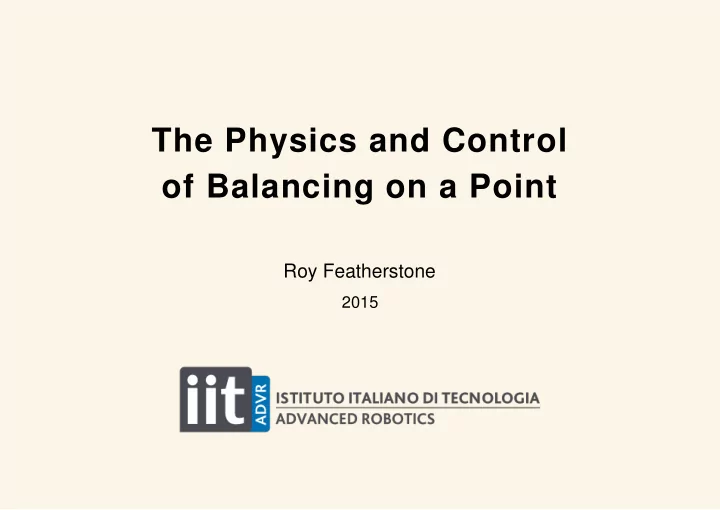

The Physics and Control of Balancing on a Point Roy Featherstone 2015
Robots do not always have a polygon of support. Sometimes they have to balance actively. 2
Balancing is usually seen as a control problem, but it is also a physical process , and can be analysed as such. 3
Physics of Balancing on a Point The simplest case: A planar double pendulum with an actuated joint balancing on a sharp point in 2D (a knife edge in 3D). centre actuated joint of mass passive joint 4
Physics of Balancing on a Point Objectives: 1. Maintain balance: 2. Follow commanded motion: The control problem: The controller must control 4 variables ( , , and ), but has direct control of only one variable: 5
Physics of Balancing on a Point The control solution: (in principle) If a control system succeeds in driving a variable to zero, then a side-effect is to drive , , etc. also to zero. time 6
Physics of Balancing on a Point The control solution: (in principle) So we seek a new set of state variables to use in place of , , and with the property that controlling one has the side-effect of controlling the other three. 7
Physics of Balancing on a Point Analysis: Let be the angular momentum of the robot about the support point. has the special property that is the moment of gravity about the support point. 8
Physics of Balancing on a Point Analysis: Where are elements of the joint-space inertia matrix, is the mass of the robot, and is the acceleration of gravity. Observe that and are linear functions of velocity. 9
Physics of Balancing on a Point Analysis: As and are linear functions of and , we can invert the equations and write where and are functions of and only, and can be calculated easily via standard dynamics algorithms. 10
New Model of Balancing The result is a new model of the balancing behaviour of the robot in which the state variables are , , and , the input is and the output is , controlling has the side-effect of maintaining the robot's balance 11
New Model of Balancing The result is a new model of the balancing behaviour of the robot in which the state variables are , , and , the input is and the output is , controlling has the side-effect of maintaining the robot's balance 12
New Model of Balancing To control the robot we 1. map , , and to , , and , 2. apply a simple control law to calculate , 3. convert to or as required 13
Balance Controller the gains are simple functions of , and the user's choice of poles 14
Balance Controller optional 15
Balance Controller 16
A Bit More Physics where is the robot's natural time constant of toppling , treating it as a single rigid body is the linear velocity gain of the robot, which measures the degree to which motion of the actuated joint influences the horizontal motion of the CoM 17
A Bit More Physics A robot's velocity gain expresses the instantaneous relationship between motion of the actuated joint(s) and the resulting motion of the centre of mass. For the double pendulum, where both velocity changes are caused by an impulse at joint 2. 18
A Bit More Physics If is large then the robot is good at balancing disturbance response recovery But if is small.... disturbance response hits failure joint limit 19
How Well Does it Work? 2.5 2 1.5 fast radians accurate tracking 1 step of linear ramp response 0.5 0 −0.5 −1 0 1 2 3 4 5 6 7 8 seconds 20
How Well Does it Work? 2.5 2 1.5 radians 1 non-minimum 0.5 phase behaviour 0 (but we can fix this....) −0.5 −1 0 1 2 3 4 5 6 7 8 seconds 21
Leaning in Anticipation Instead of this . . . why not do this? start start responding leaning here here This behaviour can be implemented by changing the command input to the controller. 22
Leaning in Anticipation 2.5 2 1.5 1 modified command 0.5 0 −0.5 no anticipation anticipation −1 0 5 10 15 20 25 23
The End Further reading: http://royfeatherstone.org/skippy/ http://royfeatherstone.org/publications.html 24
Recommend
More recommend